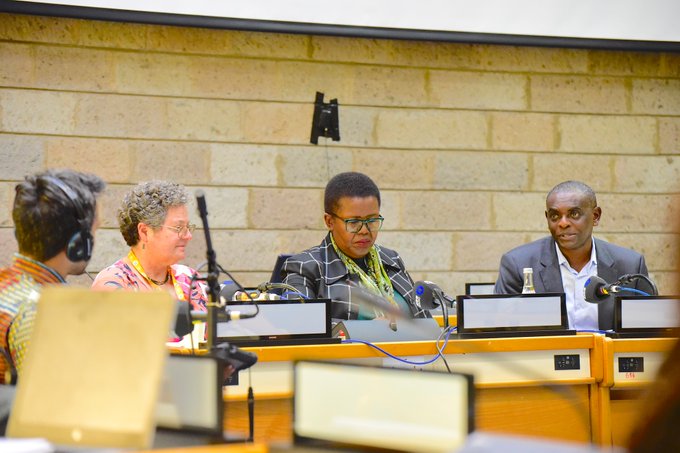MAI MAHIU, Kenya – A majority of farmers across the African continent face challenges while dealing with soil degradation, deforestation, and biodiversity loss, especially in arid and semi-arid regions.
Sylvia Kuria, the founder of Sylvia’s Basket and an organic farmer, owns land in Mai Mahiu, Nakuru County and is one of such farmers.
She champions agroecology by growing organic, pesticide-free food and training women and small-scale farmers on how to cultivate their food using agroecological principles.
But Sylvia didn’t get here by chance; hers is one of many inspiring stories of African farmers applying agroecology to grow food.
Sylvia recounts how she acquired her piece of land about seven years ago when it was really dry.
“It was a bushy land. We didn’t have anything, but we built the land from the ground up. When we came here, we noticed that we were not very far from Mt. Longonot,” says Sylvia.
The area around Mt. Longonot is rich in volcanic soils, which turn out to be very sodic, meaning that these kinds of soils are highly salty, so not many crops can grow there.
How Sylvia Kuria managed to restore her degraded land
Against this backdrop, Sylvia had to devise ways of restoring her degraded land into a productive resource.
“For the first four years we were here, we planted over 4,000 trees. We planted different species of trees, but we focused on planting nitrogen fixers,” she explained.
She also focused on planting fruit trees to ensure that together with her family, they had enough food security.
“We also planted aesthetic trees for beautification and also trees that have a lot of flowers like acacia because we have beehives around here. We just wanted to make a microclimate that would work for us,” narrated Sylvia, who has gotten a lot of support from Power Shift Africa.
Compacted soil suffocates roots, limits water & nutrient uptake, slashing harvests. Loosen up with cover crops, reduced tillage—yields rebound fast. #SoilHealth #SustainableFarming #Agroecology
Like any other farmer would do, Sylvia wanted to venture into commercial farming.
“So, we started by farming high-value crops, but sometimes we went through a lot of losses, especially when you grow crops like onions and tomatoes, which are very high-value crops, but they are very difficult to propagate in soils that are high-salted and sodic,” she lamented.
Which are the indigenous crops that Sylvia Kuria grew
So, Sylvia had to go back and grow their indigenous crops.
“We planted sorghum, sweet potatoes, and cassava because they do exceptionally well. We have a block where the soil was completely degraded. We tried planting onions for three seasons, but nothing happened. We planted cabbage; nothing. We tried beans, but they refused to do well there,” explained Sylvia.
Following this devastating encounter, Sylvia had to learn that sometimes, when you want to adapt to your kind of climate, the secret is to go back and grow your local indigenous crops.
#CGIARScienceWeek | @alexawiti, CIFOR-ICRAF’s Principal Scientist & Agroecology Lead, participated in a special live recording of the @BBC World Service CrowdScience show, held on the sidelines of @CGIAR Science Week.He emphasised the transformative role of #agroecology in
This is because indigenous crops are climate-resilient, and a big bonus about having such crops is that they are nutritionally dense.
“Just think about the nutrition you get from cassava, sweet potatoes, sorghum, millet, and indigenous leafy vegetables, which also do very well here,” said Sylvia.
What is Sylvia Kuria’s message to her fellow farmers
Additionally, she does two to three composite piles every week because she is growing their food on almost three acres of land, and since that land is too big, she always thinks about ways of regenerating the soil.
“So, we do a lot of compositing. We also do a lot of biomass because we are growing shrubs like tithonia, which is a very good shrub. After all, it is high in phosphorus and nitrogen, so it works very well,” Sylvia explained.
Tithonia, according to Sylvia, is also a good pesticide, and on top of that, the plant, also known as the Mexican sunflower, is fodder for the animals; especially goats love it.
“So, one thing I normally tell farmers is to start with agroforestry. Always plant trees and shrubs. Make sure that as much as you can, make sure that you have biomass so that you can reduce inputs into the farm,” added Sylvia.
Something else Sylvia does on her farm is water harvesting.
“We have a dam here on the farm that helps us to collect rainwater, and the water has fish, which fertilises the water, which I use to water my crops. So, you find that we are always fertilising the soil in a sustainable manner that doesn’t harm the climate or the environment in any way,” she concluded.








